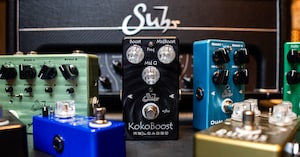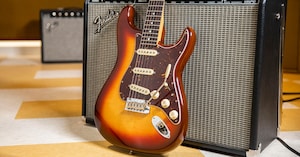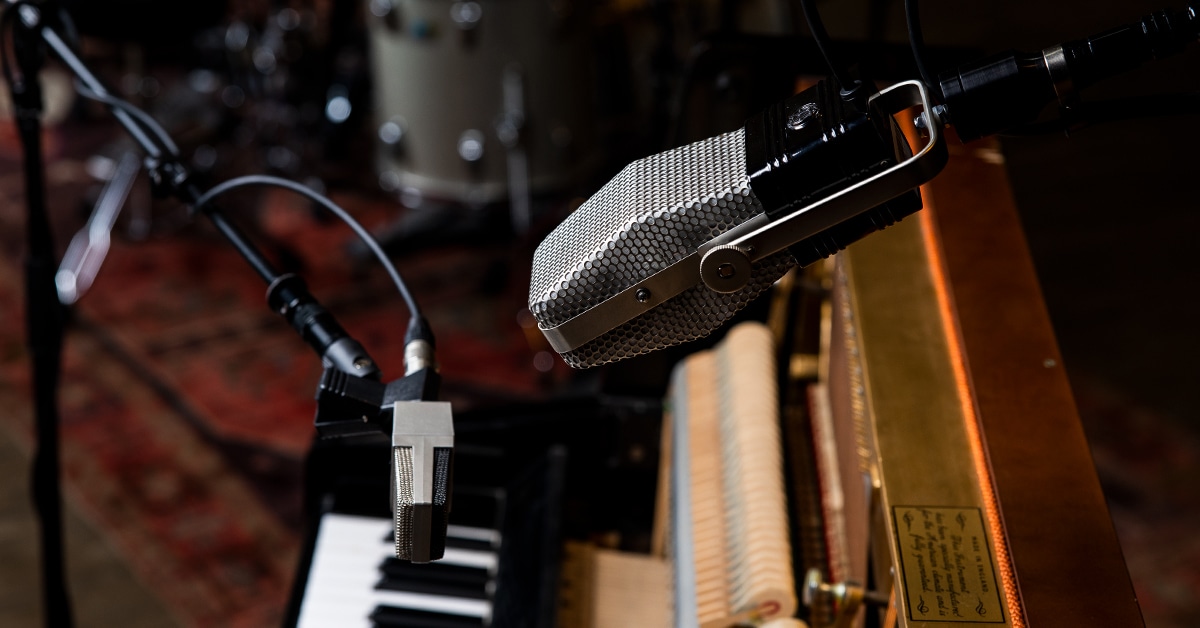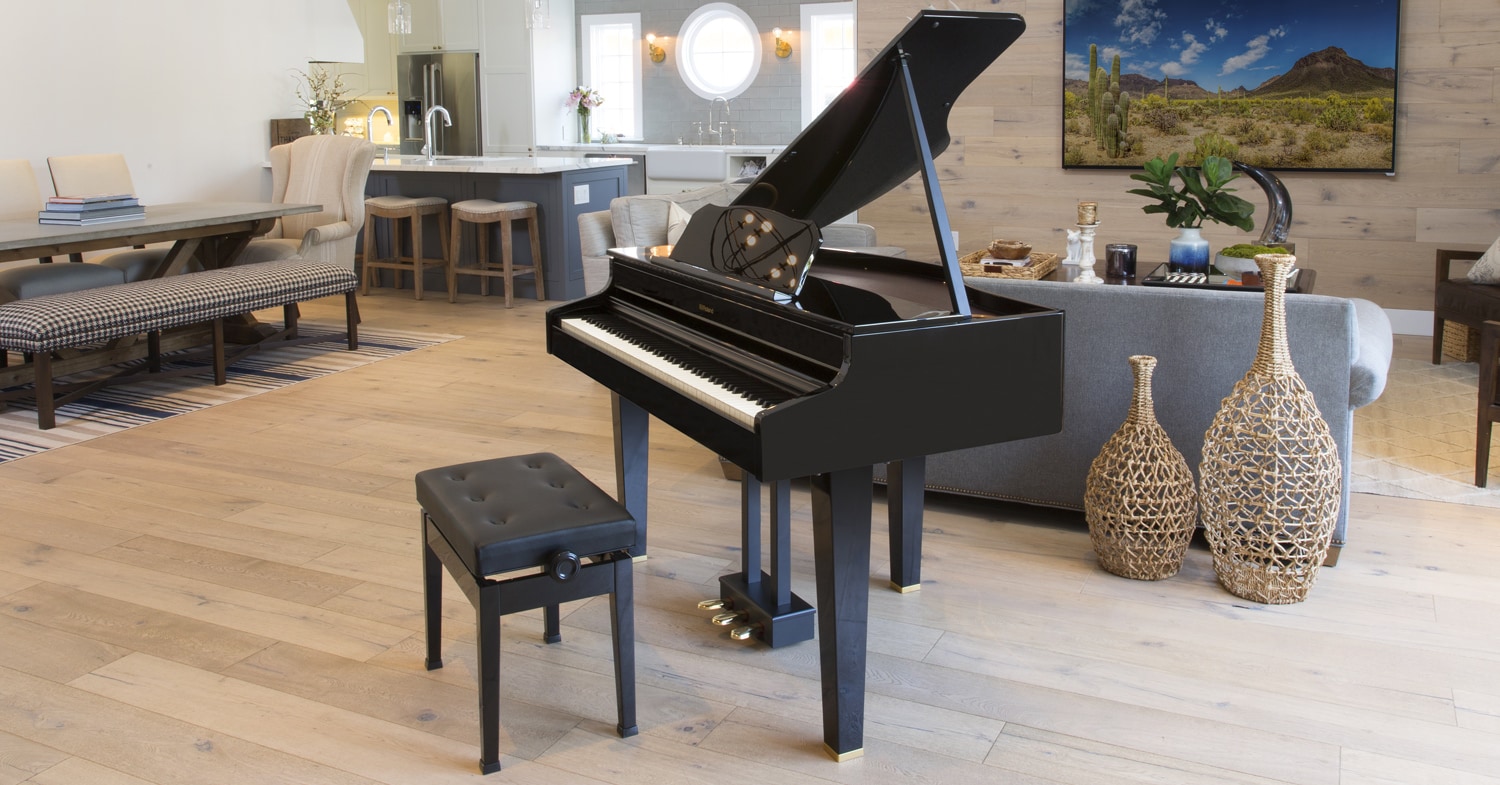There was a time, even up into the 1970s, when having a piano in your living room was a sign that you had attained a certain level of cultural sophistication. It was an indication that you appreciated music, and that you and your household were able to make music for friends and family. As the world became more mobile, and living space got a little smaller, the home piano started to fall out of fashion. We think that’s a shame—and so did Roland. From their founding in the early ’70s, Roland has been on the leading edge of developing electronic and digital pianos, both for the stage and for the home. From the EP-10, Roland’s first totally electronic piano, to their spectacular 50th Anniversary Concept Model, they have been on the cutting edge. Roland’s sublimely attractive home pianos now rival the level of sound and performance as you get from top-of-the-line stage pianos.

Pictured: Roland 50th Anniversary Concept Piano
A Modest Beginning
When Ikutaro Kakehashi founded Roland in 1972 after leaving Ace Electronics, he was already an established keyboard designer, having created the SX601 organ for Technics. Although he was, at that point, mostly known for designing the Rhythm Ace drum machine (see our article on the LinnDrum for a little history of drum machines), and Roland’s first product was the TR-77 drum machine, innovative keyboards were soon to come. First, the SH-1000, the first synthesizer designed and built in Japan, shortly followed by the EP-10, which was Roland’s first fully electronic piano. This design was very different from electric pianos like the Rhodes and Wurlitzer, which were, in essence, mechanical pianos with a pickup system for amplification, otherwise referred to as “electro-mechanical” pianos.
Certainly, by the standards of modern electronic and digital pianos, the EP-10 was pretty primitive. It merely had 61 keys on an organ-style keyboard action with no touch sensitivity, and four basic sounds (two pianos and two harpsichords) that were drawn from the synthesizer technology used for the SH-1000. It was not an instrument intended for performances of the great pieces of Mozart, Beethoven or any of the classical composers. But it was light, portable and had a vibe of its own. It was followed fairly quickly by the EP-20, which added a mixing section that could combine the piano and harpsichord sounds. But it was the EP-30, in 1974, that was a major game changer.
Advancing by Touch
The EP-30 was the first electronic keyboard with touch sensitivity, allowing a level of dynamic response that engaged many players. “Roland has devoted a lot of its innovation to piano technology, and a lot of modern technologies that seem commonplace today originated in the early ’70s with Roland pianos. The electronic piano with touch sensitivity was a Roland first that set us on a path for a lot of innovations that happened following that,” says Roland’s Corey Fournier. The EP-30 was still saddled with an organ-style, non-weighted action, though, and that kept a number of players sticking to the older electro-mechanical instruments. But that wall would soon crumble.
In 1977, Roland released the MP-700, which expanded the range to 75 keys and, a first for Roland, added a weighted-action keyboard. While perhaps less of a success than Roland might have hoped, due to the size and weight of the unit, it was another groundbreaker and a major step in the ongoing evolution of Roland pianos. The next step along the way may not have been Roland’s alone, but it was one they were heavily involved in, and one that echoes through the musical instrument world to this day—MIDI.
Gaining Control
The history of how and why the MIDI (Musical Instrument Digital Interface) standard was developed would be the subject of another article. Considering the impact this simple means of controlling keyboards, sound modules and a multitude of other devices has had over the 40 years of its existence (Wow! Has it been 40 years? Really?), it certainly deserves that. Roland was one of the major players in the process and one of the first two companies to release keyboards that incorporated MIDI—in their case, the legendary Jupiter-6. “While the first MIDI instruments that Roland debuted were synthesizers, we also had the first MIDI pianos. The Jupiter-6 was first along with the JX-3P, but our concurrent piano models were leading with that technology as well,” says Fournier.

Pictured: Roland RP701 Digital Upright Home Piano
Those first MIDI-equipped pianos were the HP300 and HP400, which were solidly aimed at the home piano market, rather than the professional musician. It’s interesting indeed that this technological revolution’s first appearance on a piano was for the home rather than the stage. But this follows a pattern Roland set early on—taking the best available technology and adapting it to instruments that crossed the gap between professional and home. This pattern would be repeated with Roland’s next advance, Structured Adaptive Synthesis (SAS).
Stepping Into the Digital World
First developed for professional-level instruments, SAS can, in many ways, be considered a precursor to, if not the first, instrument modeling system. Part of what SAS does (and this is a gross simplification) is use zoned samples of an instrument, and then reduce those samples to algorithms that are based on how dynamics affect harmonic content. It was certainly the first purely digital piano system Roland developed, and it was soon ported to pianos for the home. “The RD-1000 was the first Roland piano with Structured Adaptive technology, and was a stage piano—a pro-level instrument. And then that came to be the sound engine of our HP models, which was the first home piano line to utilize SA technology,” Fournier says. “So, there have certainly been times when the synthesizer technology has fed the home piano technology.”
SuperNATURAL and Super Models
These crossovers and hybrid approaches have certainly made for exciting advances over the years, with one of the major technologies that play across both professional and home instruments being Roland’s SuperNATURAL sound engine. Combining the strengths of both sampling and modeling, a couple of the SuperNATURAL engine’s big advantages are relative efficiency, with less digital signal processing (DSP) power needed than for a purely modeling system, and greater dynamic range and more natural response than a purely sample-based system could provide.
Fournier puts it, in more detail, “With SuperNATURAL, sampling gives us the initial tone, but then the modeling takes over and creates a linear note decay, versus a looped version of the sound. Also, with the changes in dynamics you typically have in a digital piano, you might have four crossfades or four different switch points, which is something that you will perceive to varying degrees when you’re playing that instrument. With SuperNATURAL technology, instead of having that ‘stair-step’ sound, you have a linear progression between the quietest sound and the loudest sound, and back and forth. So, you get a much more realistic sense of both decay, which is linear, and then volume changes in the different dynamics, which will also be linear.”

Pictured: Roland RP102 88-Key Digital Console Piano
One big advantage that Roland has is their commitment to R&D. This was very much in the fore with their development of physical modeling systems. Starting with the V-Guitar system in the mid-’90s and the development of the V-Drums systems, Roland’s physical modeling of instruments has always been at the leading edge of what’s possible, and the range of fully modeled V-Piano systems speaks to the versatility of that approach.
For a little deeper dive on that, we turn to Fournier. “With the full modeling approach—the V-Piano for example—that’s when we took it to the highest level,” he says. “It’s not taking a sample and improving it with modeling. We’re creating a digital model of each component of the piano: the soundboard, the harp, the physical structure, the wood frame, the hammers themselves, and, of course, the string materials. You start to see that there’s an acoustic relationship between all of the things inside of a piano that create the sound. And, if you change one of them, it’s going to change all of them. So, with the V-Piano being all modeled components, you have the ability to change things like the hammer hardness, or the string material, or the soundboard material. What kind of wood is it? How long is the instrument? You can actually stretch the length of the piano in a virtual software environment, and you get full control over that instrument. And so, from one preset to the next, it could be a baby grand with a very traditional kind of sound, or a massive concert grand with a very avant-garde kind of a sound.”
Where the Action Is
A piano is much more than just the sound, and Roland pays equal attention to the keyboard action and construction. They have come a long way since their very earliest weighted-action keyboards, indeed. The current action is as close to a full-escapement acoustic piano keyboard as it’s possible to get.

Pictured: Roland HP702 Digital Upright Piano
To dig a little deeper, Fournier explains, “Something that Roland also has developed on our own is a very highly refined piano action that has been part of our piano story and part of most of our instruments, even at a low-cost level for about the last six or seven years or so. Our PHA-4 action has multiple sensors for fast response and the “PHA” stands for Progressive Hammer Action. This is the idea of having a keyboard action that doesn’t have the same amount of weight everywhere on the instrument, just like an acoustic piano. On an acoustic piano the lower hammers are bigger because they have to strike those bigger strings, so the hammers are a little bit heavier. As you progress to the higher end of the keyboard, the hammers are a little bit lighter. So, having that progressive hammer action and the ability to control it with the feeling of the escapement point—where you feel the release of the hammer as it hits the string—allows a high level of expressive capability.” This PHA-4 action is available on all Roland digital pianos with weighted key action, even entry-level models, starting at the beginner-favorite FP-10—all the way up to the RP-102, RP-701, RD-88, FANTOM-08 and even the upright cabinet model HP-702 digital piano. This gives a major advantage for players from beginners to the most experienced, and it makes transferring from one level of piano to the next that much easier.
Great Sound Demands Great Looks
The final consideration, especially for the home piano, is the aesthetics, something to which Roland has always paid attention. Roland’s designers are aware of the range of physical environments in which their pianos will be placed and are committed to providing a look that will blend into whatever room in which you want the piano to live. From simple to ornate, and in collaboration, in some cases, with internationally known designers, Roland provides pianos that will slot in. We are especially enamored by some of their more adventurous designs, with the 2020 Facet and the stunning 50th Anniversary Concept piano, which push the limits while still being spectacular instruments with amazing sound and playability.










